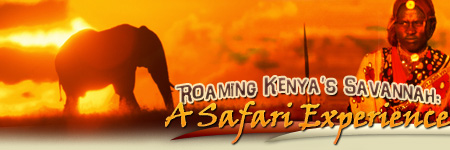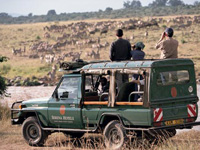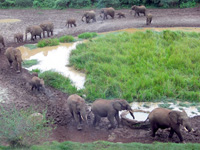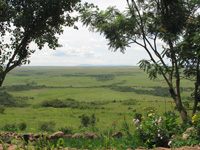|

Visit Kenya's Savannah on an African Safari
by Susan McKee
As I scanned the horizon, memories of summer camp flooded into my mind. “Going on a squeegy hunt,” my counselor would begin chanting, her hands beating a slow marching cadence on her thighs. “Gonna catch a big one. I'm not afraid.”
 |
The children’s song, complete with hand gestures and sound effects, no doubt was inspired right where I was – on safari in Kenya. If we’d been on foot instead of cosseted in a Toyota Land Cruiser, we would have been “going on a hunt,” rustling through waist-high grass and climbing the occasional tree for a better view.
Like the colonial trophy-seeking hunters of the 19th century, we were stalking the “big five,” searching the savannah for elephant, rhino, leopard, lion and buffalo. But, instead of guns, we intended only capture by camera.
During our week on safari, we must have seen several hundred elephants, thousands of buffalo, a dozen rhinoceroses and a half-dozen juvenile lions, but we never spotted a leopard. Truth be told, the “poster” animals are easier to observe in American zoos.
My first stop was the Serena Mountain Lodge, perched in the foothills of Mount Kenya. The guestrooms are at treetop height with a full wall of windows overlooking an ancient briny watering hole. Oblivious to the huge spotlights left on all night, animals of all sorts took their turns wallowing in the salty mud and drinking from the tank of fresh water provided by the resort, no doubt in expiation for the bright lights.
Early the next morning, I looked out my window to see two dozen elephants amble single file out of the forest. They spent 20 minutes around the pond, then headed off to wherever they were planning to browse (elephants eat 500 pounds of greenery in an average day). That’s never happened outside of my window before! It was a great introduction to Kenya, where vast game preserves allow wildlife to roam unfettered, attracting tourists by the busload.
After breakfast, our group of six travelers got back in the van to drive north to the Samburu Game Preserve. Crossing the equator, our driver paused for a welcome potty break alongside a collection of shops named by enterprising merchants with such tempting monikers as “The Chicago Shop,” “New York Shop” and even “Noah’s Ark.” Inside the stalls, the offerings were much the same: wood carvings of animals, traditional masks and bead jewelry.
Outside, a group of savvy young men put on a show for the tourists demonstrating how water swirled out of a hole in the bottom of a bucket in different directions north and south of the equator. In case you’re wondering, it’s a trick. Yes, there is a Coriolis effect that causes liquids and gases to move differently north and south of the equator, but no, it doesn’t apply at this level. The spiral of the draining water is determined by the person holding the basin, not the earth’s spin. Nevertheless, it’s an entertaining show, and those of us who proffer tips receive certificates of having crossed the equator in return. Not a bad deal, really.
After another hour’s ride, we checked into the Samburu Serena Lodge just a day after it had reopened – floods earlier in May had filled the detached rooms with mud. All that rain, however, meant that the foliage was thick and green. There were animals in profusion to be seen in the Samburu Game Preserve.
 |
Here is “nature raw in tooth and claw”. Protected from the predations of humankind, animals are free to play out their preordained roles in the food chain. Large herds of ungulates – impalas, waterbucks, gazelles, antelopes, wildebeest, zebras -- are just dinner-on-the-hoof for the carnivorous predators. The massive herbivores – rhinos, hippos, elephants – graze undisturbed.
Although we never did find one of the especially photogenic “king of the jungle” lions with a huge mane, we did see a group of adolescent males and a lioness – likely their mother.
Our final safari stop was the enormous Masai Mara Game Preserve in Kenya’s southeast, bordering the vast Serengeti in Tanzania. This park is the site of the annual summer migration of an estimated 1.5 million wildebeest and zebra across the Mara River – unfortunately for us, not during our visit.
Our twice-daily trips into the plains flushed out many varieties of animals, including baboon, topi, elephant, jackal and giraffe. We’d always see a rhinoceros or two, enormous herds of buffalo, wary groups of warthogs, occasional flocks of exotic birds, and a half-dozen dik-diks, a species of antelope about the size of a small dog.
 |
We spied ranks of crocodiles lined up to sun themselves along the river bank, and, in the water, dozens of twitching nostrils and ears of hippopotamuses (all that’s visible of those massive beasts as they walk along the river bottom). On one early morning trip we caught sight of a hippo his way to the river. Evidently anxious to avoid our gaze, he attempted to hide his burly self behind a humorously dwarfed bush.
Crocs spend much of their time not moving a muscle, just watching and waiting for unwary prey. Some of the most violent footage of the annual wildebeest and zebra migration includes the predation of crocodiles in the Mara.
We stayed at the Mara Serena Resort. High on a bluff alongside the plains, it offers a 360-degree view of the vast grassland.
One morning, the resort served us breakfast at river’s edge. A guard led us, one by one, to a creek bank nearby, where a crocodile kept watch not more than 20 feet away. As I came into view, it opened its eyes in a chilling half-lidded gaze, seemingly contemplating the effort versus the reward of lunging toward me. Fortunately, it made a decision for continued inactivity, and no resort guests were eaten as crocodile breakfast!
My safari was arranged by Travel Wild East Africa. Its attention to detail was magnificent, and the guide (thank you, Guy Gullacksen) absolutely superb.
Although Kenya is located on the equator, the weather on safari wasn’t tropical because of the altitude. Nairobi, for example, is almost as high as Denver. Sunscreen is a must, as is a hat and mosquito repellent.
|